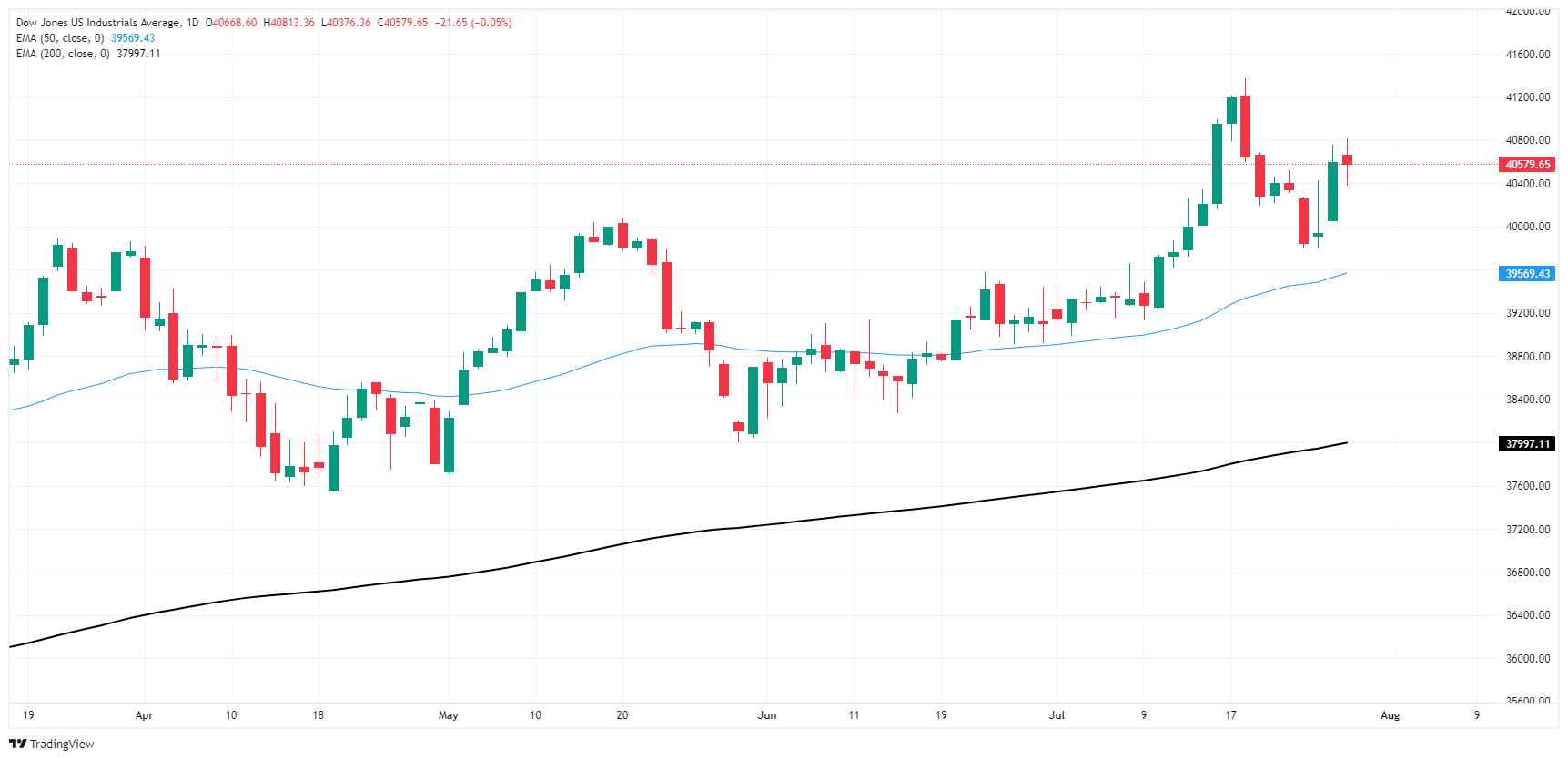Dow Jones Industrial Average flattens as investors await Fed rate call
- Dow Jones churns chart paper as investors jostle for position ahead of Fed.
- Fed set to hold rates steady this week, markets on the lookout for forward guidance.
- Investors have fully priced in a rate trim in September.
The Dow Jones Industrial Average (DJIA) spun in circles on Monday, churning around 40,600.00 as investors buckle down for the wait to the Federal Reserve’s (Fed) latest rate call. The Fed is broadly expected to hold rates steady on Wednesday, but markets will be keeping an eye out for any adjustments to forward guidance ahead of the key September rate call.
The Fed’s upcoming rate call on Wednesday will be closely watched as investors look for signs that the Fed is on pace to deliver a hotly-anticipated rate cut when the Federal Open Market Comittee (FOMC) convenes again in September. Markets are broadly anticipating at least a quarter-point rate cut on September 18, with rate markets pricing in 90% odds of a 25 bps trim and hopeful 10% bets for a double-cut according to the CME’s FedWatch Tool.
US Nonfarm Payrolls (NFP) are also due on Friday, a key component of the Fed’s employment mandate and investors will be looking for a continued cooling in hiring figures to help keep pushing the Fed into a new rate-cutting cycle in September. ADP Employment Change figures for July will be published on Wednesday, and will serve as a forecast for Friday’s NFP jobs report, albeit a shaky one with a spotty track record for accuracy.
Dow Jones news
The Dow Jones is stuck in the midrange amid quiet Monday trading, with roughly half of the index in the green for the day and the other half easing into the low end. McDonald’s Inc. (MCD) reported a miss in quarterly revenue and earnings per share, but the stock rallied 3.74% and rose to $261.42 per share as the company vows to make more efforts to engage in competition by taking a “forensic look” at pricing options and expects per-restaurant traffic to increase with the addition of value offerings.
Dow Jones technical outlook
The Dow Jones is holding steady near the 40,600.00 handle on Monday, cycling in a tight range for the day as investors grapple with keeping a near-term recovery on-balance. The DJIA briefly tumbled below the 40,000.00 major price handle last week after US markets pulled back from record highs.
The Dow Jones dug in its heels to put in a fresh near-term bottom near 37.395.00, but is still trading on the low side of recent record highs set at 41,371.38. Long-term momentum still leans firmly into the bullish side as the Dow Jones trades well above the 200-day Exponential Moving Average (EMA) at 38,011.80.
Dow Jones daily chart
Dow Jones FAQs
The Dow Jones Industrial Average, one of the oldest stock market indices in the world, is compiled of the 30 most traded stocks in the US. The index is price-weighted rather than weighted by capitalization. It is calculated by summing the prices of the constituent stocks and dividing them by a factor, currently 0.152. The index was founded by Charles Dow, who also founded the Wall Street Journal. In later years it has been criticized for not being broadly representative enough because it only tracks 30 conglomerates, unlike broader indices such as the S&P 500.
Many different factors drive the Dow Jones Industrial Average (DJIA). The aggregate performance of the component companies revealed in quarterly company earnings reports is the main one. US and global macroeconomic data also contributes as it impacts on investor sentiment. The level of interest rates, set by the Federal Reserve (Fed), also influences the DJIA as it affects the cost of credit, on which many corporations are heavily reliant. Therefore, inflation can be a major driver as well as other metrics which impact the Fed decisions.
Dow Theory is a method for identifying the primary trend of the stock market developed by Charles Dow. A key step is to compare the direction of the Dow Jones Industrial Average (DJIA) and the Dow Jones Transportation Average (DJTA) and only follow trends where both are moving in the same direction. Volume is a confirmatory criteria. The theory uses elements of peak and trough analysis. Dow’s theory posits three trend phases: accumulation, when smart money starts buying or selling; public participation, when the wider public joins in; and distribution, when the smart money exits.
There are a number of ways to trade the DJIA. One is to use ETFs which allow investors to trade the DJIA as a single security, rather than having to buy shares in all 30 constituent companies. A leading example is the SPDR Dow Jones Industrial Average ETF (DIA). DJIA futures contracts enable traders to speculate on the future value of the index and Options provide the right, but not the obligation, to buy or sell the index at a predetermined price in the future. Mutual funds enable investors to buy a share of a diversified portfolio of DJIA stocks thus providing exposure to the overall index.
